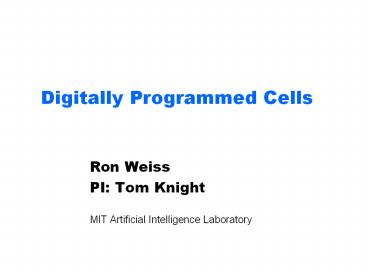Digitally Programmed Cells - PowerPoint PPT Presentation
Title:
Digitally Programmed Cells
Description:
Interface to chemical world. Molecular scale engineering. Microbial Robotics ... simulates protein and chemical concentrations ... – PowerPoint PPT presentation
Number of Views:17
Avg rating:3.0/5.0
Title: Digitally Programmed Cells
1
Digitally Programmed Cells
- Ron Weiss
- PI Tom Knight
- MIT Artificial Intelligence Laboratory
2
Goal
- Process-Control Cellular Computers --Microbial
Robotics - Unique features
- small, self-replicating, energy-efficient
- Purposes
- Biomedical applications
- Environmental applications (sensors effectors)
- Embedded systems
- Interface to chemical world
- Molecular scale engineering
3
Microbial Robotics
- Potential to engineer behavior into bacterial
cells
- phototropic or magnetotropic response
- control of flagellar motors
- chemical sensing and engineered enzymatic release
- selective protein expression
- molecular scale fabrication
- selective binding to membrane sites
- collective behavior
- autoinducers
- slime molds
- pattern formation
- Example timed drug-delivery in response to
toxins
Toxin A
kills
pathogen
Toxin A
pathogen
Antibiotic A
detection
Customized Receptor Cell
antibiotic synthesis machine
4
A New Engineering Discipline
- System design
- interfaces to sensors
- in-vivo logic circuits
- interfaces to actuators
- Strategy reuse and modify existing mechanisms
- characterize, then combine control elements
- modify elements to generate large component
libraries - implement transgenic signalling pathways for I/O
5
Outline
- Implementing in-vivo computation
- Experimental effort
- System design methodology
- Programming Cooperative behavior
- Challenges
6
Implementing the Digital Abstraction
- In-vivo digital circuits
- signal concentration of specific protein
- computation regulated protein synthesis decay
- The basic computational element is an inverter
- Allows building any (complex) digital circuit in
individual cells!
7
Inverter Characteristics
signal
L
T
C
rA
fA
fZ
yZ
cooperative binding
transcription
translation
repression
input protein
output protein
mRNA synthesis
input protein
mRNA
- inversion relation I
- ideal transfer curve
- gain (flat,steep,flat)
- adequate noise margins
fZ I (fA) L T C (fA)
8
Experimental Effort
- First, characterize several inverters
- genes from Lambdoid phages (cI, PR)
- measure points on the transfer function
- Typical fluctuations in signal levels
- constitutive expression of GFPwith a synthetic
promoter
output
input
9
Digital Circuits
- With properly designed inverters, any (finite)
digital circuit can be built
C
A
C
D
D
gene
B
C
B
gene
gene
- proteins are the wires, genes are the gates
- NAND gate wire-OR of two genes
10
Proof of Concept Circuits
- Building several simple circuits
- Simulation results are promising
RS-Latch (flip-flop)
Ring oscillator
_ R
A
_ R
_ S
A
B
time (x100 sec)
B
B
_ S
C
A
time (x100 sec)
time (x100 sec)
11
BioCircuit Design (TTL Data Book)
- Data sheets for components
- imitate existing silicon logic gates
- new primitives from cellular regulatory elements
- e.g. an inverter that can be induced
- Assembling a large library of components
- modifications that yield desired behaviors
- Constructing complex circuits
- matching gates is hard
- need standard interfaces for parts
- from black magic to you can do it too
12
Naturally Occurring Sensor and Actuator Parts
Catalog
- Actuators
- Motors
- Flagellar
- Gliding motion
- Light (various wavelengths)
- Fluorescence
- Autoinducers (intercellular communications)
- Sporulation
- Cell Cycle control
- Membrane transport
- Exported protein product (enzymes)
- Exported small molecules
- Cell pressure / osmolarity
- Cell death
- Sensors
- Light (various wavelengths)
- Magnetic and electric fields
- pH
- Molecules
- Ammonia
- H2S
- maltose
- serine
- ribose
- cAMP
- NO
- Internal State
- Cell Cycle
- Heat Shock
- Chemical and ionic membrane potentials
13
Tools
- BioSpice a prototype simulation verification
tool - simulates protein and chemical concentrations
- intracellular circuits, intercellular
communication
chemical concentration
cell
Simulation snapshot
14
Programming Cooperative Behavior
- Engineer loosely-coupled multicellular systems
that display coordinated behavior - Use localized cell-to-cell communications
- Robust programming despite
- faulty parts
- unreliable communications
- no global synchronization
- Control results in
- Patterned biological behavior
- Patterned material fabrication
- Massively parallel computation with local
communication - Suitable for problems such as physical simulation
15
High Level Programming
- Requires a new paradigm
- colonies are amorphous
- cells multiply die often
- expose mechanisms cells can perform reliably
- Microbial programming language
- example pattern generation using aggregated
behavior
16
Pattern Formation in Amorphous Substrates
Example forming a chain of inverters using
only local communications
17
Limitations
- DNA Binding Protein Logic is Slow
- milli Hertz (even with 1012 cells, still too
slow) - Limited number of intra- and inter-cellular
signals - Amount of extracellular DNA that can be inserted
into cells - Reduction in cell viability due to extra
metabolic requirements - We need a writeable long term storage
18
Challenges
- Engineer the system support for experimental
cellular engineering into living cells - Engineer component interfaces
- Develop instrumentation and modeling tools
- Obtain missing data in spec sheet fields
- Discover unknown fields in the spec sheet
- Create computational organizing principles
- Invent languages to describe phenomena
- Builds models for organizing cooperative behavior
- Create a new discipline crossing existing
boundaries - Educate a new set of engineering oriented students































